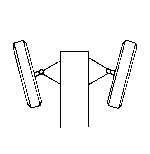
All racers know the difference between toe-in and toe-out (alignment). However, the many forms of toe-out can be confusing or misunderstood. Toe-out can be found in at least one of five main forms; static toe out, toe out on turns "ackerman steering", toe out due to bump steer, steering arm toe out, and toe out due to slip angles.
The most commonly known form of toe-out is "static" toe-out. This is where the tie rods are adjusted such that the front edges of the tires to be farther apart than the rear edges of the tires when viewing the car from above (see example below).

Another form of toe-out occurs when "Ackerman" is designed into the steering geometry. This causes the wheels to toe-out when the steering wheel is turned. This is why some alignment shops and dealerships refer to Ackerman as toe-out on turns (not to be confused with static toe-out).
Toe-out can also be the result of bump steer. The toe-out in this situation occurs during ride motions or body roll. Oftentimes the factory will use this to improve transient dynamic handling on production cars.
Another form of toe-out, popular with oval track racers, is created by having a shorter steering arm on the left spindle than on the right spindle. When the steering wheel is turned to the left, the left wheel is steered a larger number of degrees than the right wheel resulting in toe-out. However, if you turn to the right the wheels toe-in.
An unusual form of toe-out can occur at the tire's contact patch rather than at the wheel. Because the outside tire in a corner is more heavily loaded than the inside tire, the outside tire will run at a larger slip angle than the inside tire (despite th e name "slip angle," it has nothing to do with slip but rather the twisting of the contact patch in relation to the rim). This additional twist in the outside contact patch can result in the contact patches being toed-out.
These various forms have advantages and disadvantages. One objective in using toe-out with a race car is to increase the turning force generated at the front of the car. So, if your race car understeers (pushes) in the middle of a turn, then a little toe-out may help reduce or cure your problem.
The trick with toe-out is not to apply such a large amount as to cause the inside tire to exceed its grip and make it slide. This will reduce the overall turning forces. However, if the proper amount of toe-out exists, then the inside tire will generate a drag force. This drag force creates a torque (moment) on the whole car and helps turn it in the correct direction. The effect is essentially the same as "cutting brakes" on a dune buggy.

Also, when it is cool, some racers will increase the static toe-out to help keep tire temps up on tracks with long straights.